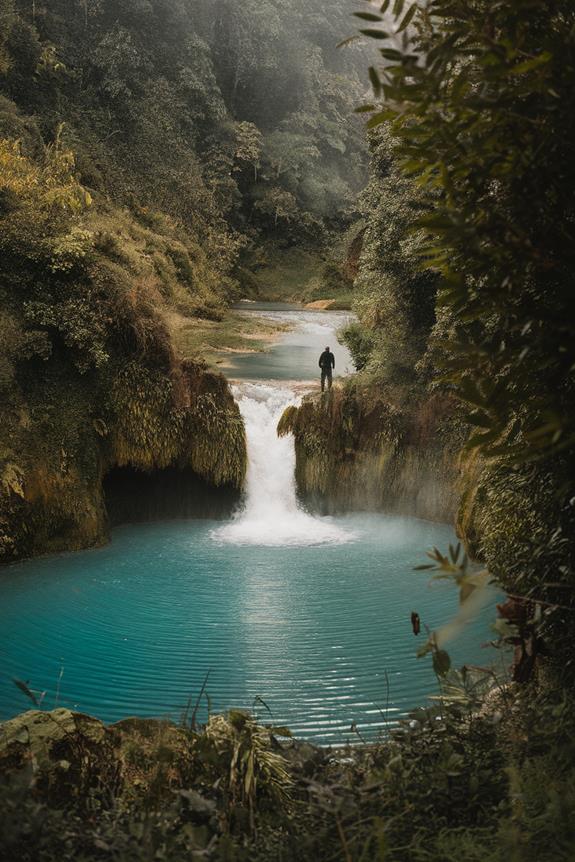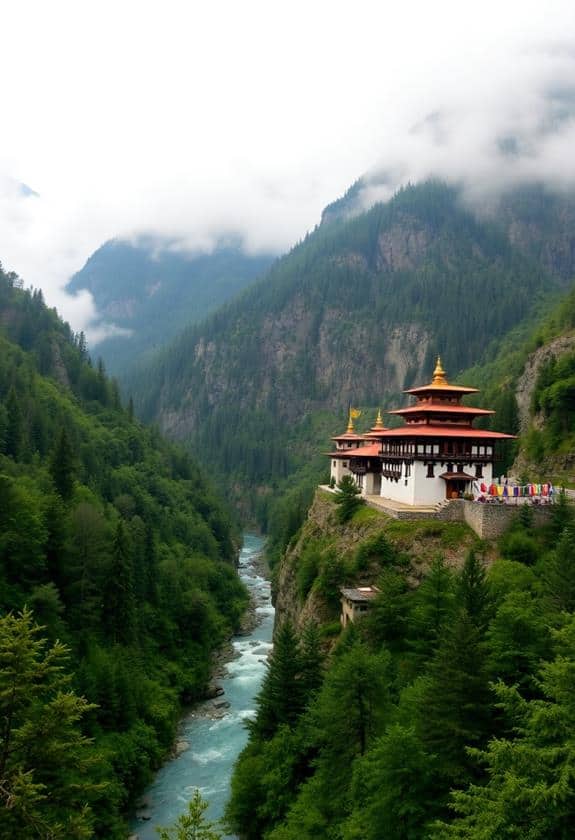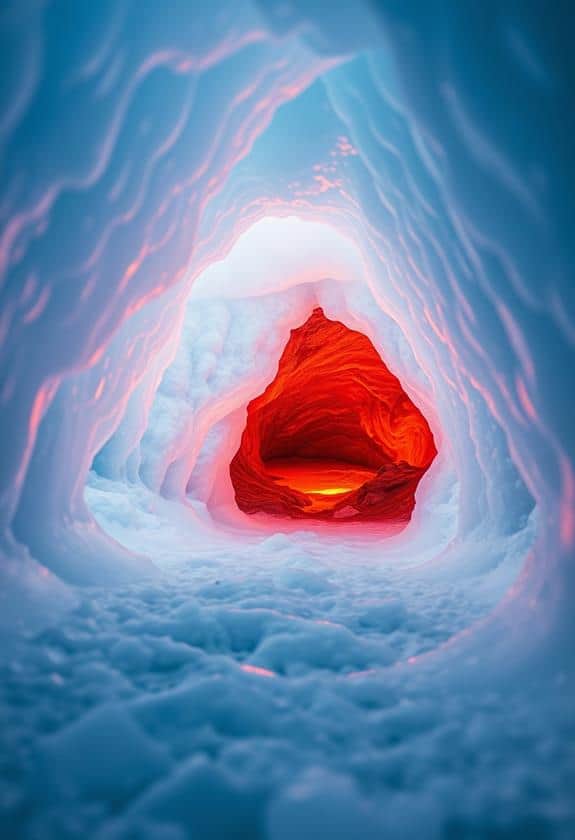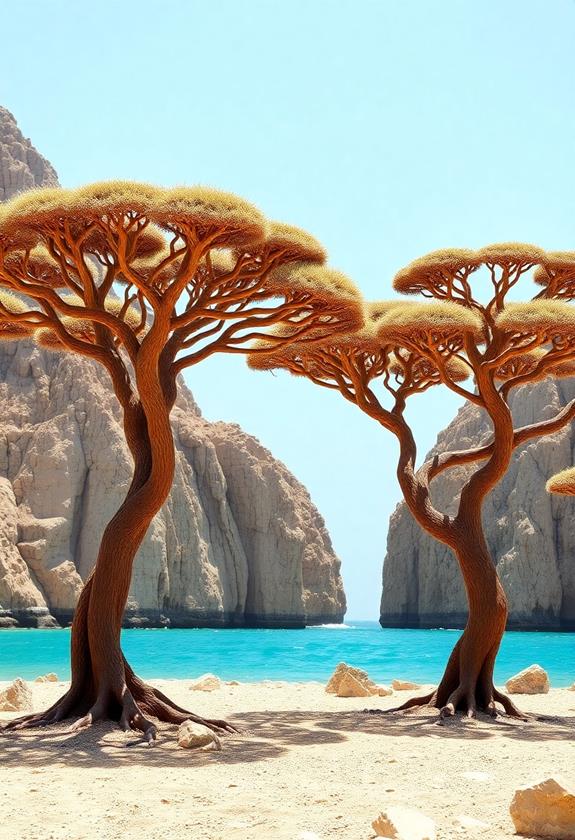
Uncharted Thrills: 3 Secret Spots for Adventurers
Commence an adventure to three secret spots that offer uncharted thrills and natural wonders. You'll discover Bhutan's Lost Valley, nestled deep in the Himalayas, accessible only by a challenging multi-day trek. Explore Antarctica's hidden volcanic caves on Mount Erebus, warmed by geothermal activity and home to delicate ice formations. Experience Socotra Island's alien landscape off Yemen's coast, featuring unique flora like dragon blood trees and bottle trees. Each destination boasts untouched beauty, rare ecosystems, and diverse terrains ranging from white sand beaches to rugged mountains. These off-the-beaten-path locations promise unforgettable experiences for intrepid travelers seeking the extraordinary. Uncover the hidden secrets of these remarkable destinations.
Key Takeaways
- The Lost Valley of Bhutan offers unspoiled wilderness accessible only by challenging multi-day trek through the Himalayas.
- Antarctica's Hidden Volcanic Caves provide a unique exploration of geothermal tunnels with rare ice formations and extremophile microorganisms.
- Socotra Island's alien-like landscape features endemic flora, including dragon blood trees, and diverse terrain from beaches to mountains.
- Proper gear, including waterproof hiking boots and compact first aid kits, is essential for safely navigating these remote destinations.
- Each location has optimal visiting seasons, with Bhutan best from April to June and Socotra accessible year-round.
The Lost Valley of Bhutan

Nestled deep in the Himalayan mountains, Bhutan's Lost Valley beckons adventurers with its untouched beauty. This remote destination, accessible only by a challenging multi-day trek, offers a glimpse into an unspoiled wilderness. You'll traverse rugged terrain, crossing swift rivers and maneuvering dense forests. The valley's unique ecosystem harbors rare flora and fauna, including the elusive snow leopard and Himalayan black bear. For such demanding treks, exceptional ankle support and waterproofing are essential, ensuring your feet remain comfortable and dry throughout the journey. Prepare for extreme weather conditions, with temperatures ranging from -5°C to 20°C. Essential gear includes high-quality waterproof hiking boots, a four-season tent, and a reliable water filtration system. Local guides, familiar with the treacherous landscape, are indispensable for safe guidance. The best time to visit is from April to June, when rhododendrons bloom, painting the valley in vibrant hues. This expedition demands physical fitness and mental fortitude but rewards with unparalleled solitude and natural splendor.
Antarctica's Hidden Volcanic Caves

Beneath Antarctica's icy exterior lies a world of hidden wonders: volcanic caves carved by geothermal activity. You'll find these subterranean marvels primarily on Mount Erebus, an active volcano on Ross Island. The caves, formed by steam and gases escaping through fissures in the ice, create intricate networks of tunnels and chambers. These unique environments, warmed by volcanic heat, can reach temperatures up to 25°C (77°F), contrasting sharply with the frigid surface conditions. As you explore, you'll encounter delicate ice formations, including crystals and stalactites, shaped by the interplay of hot and cold air. For adventurers venturing into these caves, compact first aid kits are essential to guarantee safety in this remote environment. The caves also harbor extremophile microorganisms, adapted to survive in these harsh conditions. Access to these caves is strictly limited due to their fragile nature and the inherent dangers of the Antarctic environment. Specialized guided expeditions, requiring extensive planning and permits, offer the only means of experiencing these extraordinary geological features.
Socotra Island's Alien Landscape

While Antarctica's hidden caves offer subterranean wonders, Socotra Island presents an otherworldly landscape above ground. Located off the coast of Yemen, this UNESCO World Heritage site boasts unique flora and fauna found nowhere else on Earth. For adventurers seeking to capture the island's alien-like beauty, compact binoculars are essential for observing distant wildlife and intricate plant details. The island's alien-like appearance is characterized by:
- Dragon blood trees with umbrella-shaped canopies
- Bottle trees with bulbous trunks storing water
- Desert rose plants with thick, contorted stems
- Socotran fig trees with sprawling, banyan-like roots
Socotra's isolation has fostered the evolution of these distinctive species, with over 30% of its plant life being endemic. The island's diverse terrain includes white sand beaches, limestone plateaus, and rugged mountains. Adventurers can explore the Hoq Cave, spanning 3 kilometers, or hike to the summit of Skand Mountain for panoramic views. Despite its remote location, Socotra offers basic accommodations and guided tours for intrepid travelers seeking an extraterrestrial experience on Earth.
Frequently Asked Questions
What Safety Precautions Should Be Taken When Visiting These Secret Spots?
When visiting secret spots, you should prioritize safety by thoroughly researching the location beforehand. Inform someone of your plans and expected return time. Carry essential gear, including a first-aid kit, navigation tools, and appropriate clothing. Stay aware of your surroundings and potential hazards. Respect local regulations and wildlife. Don't venture off marked trails or into restricted areas. Be prepared for unexpected weather changes and bring ample water and food. Consider hiring a local guide for unfamiliar terrain.
Are These Destinations Suitable for Solo Travelers or Families?
These hidden gems can be enjoyed by various types of travelers, but they're not one-size-fits-all. Solo adventurers might find them perfect for self-discovery, while families should carefully consider their children's ages and abilities. You'll need to assess each destination's terrain, facilities, and accessibility. Some spots may require advanced skills or equipment, making them less suitable for young children or inexperienced travelers. It's essential to research thoroughly and plan accordingly, ensuring the experience aligns with your group's capabilities and preferences.
What Is the Best Time of Year to Visit Each Location?
To determine the best time to visit each location, you'll need to ponder several factors, including weather patterns, peak tourist seasons, and local events. For ideal experiences, investigate each destination's climate and seasonal attractions. You'll want to balance comfortable temperatures with lower crowd levels and potential cost savings during shoulder seasons. Additionally, some locations may have specific natural phenomena or cultural festivities that occur at certain times of the year, which could vastly improve your trip.
How Do I Obtain Necessary Permits or Permissions for These Areas?
To obtain necessary permits or permissions for these areas, you'll need to research each location's specific requirements. Contact the local park service, conservation authority, or tourism board for detailed information. They'll guide you through the application process, which may involve submitting forms, paying fees, and adhering to visitation quotas. Some areas might require advance reservations or guided tours. Be prepared to provide identification and proof of insurance. Always check for any seasonal restrictions or special conditions that might affect your visit.
What Unique Wildlife or Plant Species Can Be Found in These Locations?
You'll encounter diverse wildlife and plant species in these locations, each offering unique ecological treasures. You might spot rare orchids, endemic birds, or elusive mammals. In one area, you'll find a critically endangered frog species, while another boasts ancient, towering trees found nowhere else. The third location harbors a delicate ecosystem of cave-dwelling creatures, including bioluminescent insects. It's essential to observe without disturbing, as many species are sensitive to human presence. Always follow local guidelines to protect these fragile environments.
